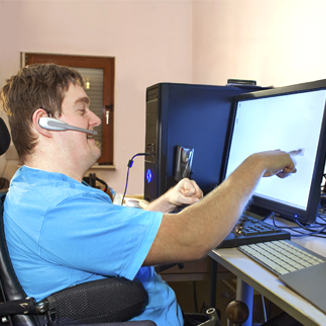
The World Wide Web Consortium (W3C) develops international web standards and is responsible for the Web Content Accessibility Guidelines (WCAG). It has recently released a gap analysis and roadmap on how to improve web accessibility for people with learning and cognitive disabilities.
Cognitive impairment or disability can cause problems with a person’s thinking, communication, understanding or memory. It can mean they have trouble paying attention, speaking, recognising people, places or things, and may mean they find new situations overwhelming.
This new W3C document looks at some of the issues people with cognitive disabilities have when using the web and provides some possible solutions. The draft document will incorporate feedback on any user needs or issues that they haven’t covered, as well as different approaches that could be used to meet users’ needs.
Challenges
In producing this report, W3C was faced with specific challenges relating to cognitive disabilities, including:
- the different kinds and levels of cognitive impairment
- the lack of existing research
- the content of a website needing to be changed, or simplified, for people with cognitive disabilities to understand it.
To address some of these challenges, W3C looked at accessibility solutions that focused on content and personalisation.
Although it wasn’t possible to cover all the different types and levels of disability, the report was able to look at eight different disabilities that crossed types and severity of cognitive impairment.
Why this document is important
 Supporting people with learning and cognitive disabilities to use the web and web-based technology, is an important part of ensuring they can take part in the community. As more information, news, social interactions and conveniences move online, people who can’t use these systems and services will feel more isolated because of their disability.
Supporting people with learning and cognitive disabilities to use the web and web-based technology, is an important part of ensuring they can take part in the community. As more information, news, social interactions and conveniences move online, people who can’t use these systems and services will feel more isolated because of their disability.
In addition, as everyday physical objects that are connected to the internet and have web interfaces become more widespread, this is going to further effect people who can’t use them.
With our aging population, the number of people with cognitive disabilities – particularly a decline in memory – is also going to increase. These are issues that need to be addressed now.
The types of accessibility issues
People with cognitive disabilities face a wide range of issues when accessing the web. These include:
- People with impaired memory may not be able to remember passwords and access codes or unfamiliar symbols.
- People with language disabilities may need clear, literal content and instructions, supporting images and familiar symbols.
- People with dyscalculia have difficulty understanding numbers and may not understand references like percentages.
- People who struggle with staying focussed may not be able to concentrate on a task if there are distractions and interruptions or if there are not enough headings and signposts to help them regain their focus.
- Many people need support to finish a task with as few errors as possible. They can struggle with complex processes such as filling out forms and entering data.
Ways to overcome these issues
The main techniques to help overcome these issues include:
- Use a clear structure for content with easy-to-follow sections and short paragraphs.
- Use an easy-to-follow writing style.
- Provide quick and direct feedback.
- Help the user to understand and navigate the content using logical and clear headings and signposts.
- Help users complete and check their work to reduce the possibility of mistakes, while also making it easier to undo mistakes when they happen.
- Help the user to focus if their attention is lost.
- Enable adaptability and personalisation, so that symbols, text and other features can be made familiar and helpful to the user.
- Avoid barriers that stop people with cognitive disabilities from using content, such as
hard-to-use security mechanisms.
Proposed strategies
The report proposes a list of strategies to bridge the accessibility gap including:
- developing a full list of techniques
- extending WCAG to include these techniques
- supporting and, where possible, enabling better personalisation of content to meet user’s needs.
The report also goes into detail about the range of issues and their solutions including:
- finding alternate security and protection measures
- ensuring user safety – keeping vulnerable users safe by protecting their information
- multi-modal content delivery – making text easier to understand by allowing people to choose the mode it is delivered in, such as text with relevant images and symbols, and
text-to-speech or video - personalisation to tailor parts of the content or functionality to meet the user’s needs and preferences.
Work in progress
The final section of the report is still a work in progress and W3C is asking for early feedback on this draft. It lists, in table format, the needs of users that are not currently addressed by accessibility. Each table covers a group of user needs by looking at their stories and suggesting solutions. For example: “As a user who has memory impairments and often forgets passwords I need to be able to use a site without remembering or copying passwords and user names so that I can use this service.”
The Information Access Group highly commends the W3C for looking into this area so thoroughly. The recommendations in the report are very much in line with our ethos around ensuring that simplicity and ease of use are achieved in web design and development projects. We heartily agree that WCAG should be extended to consider the needs of people with cognitive disability.
You can read the full Cognitive Accessibility Roadmap and Gap Analysis on the W3C website.


